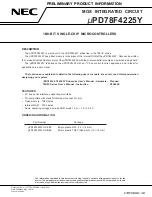
2.5.9 Motor Cables
See Technical data for correct dimensioning of motor cable cross-section and length. Always comply with national and local regulations on cable cross-
section.
NB!
If an unscreened/unarmoured cable is used, some EMC requirements are not complied with, see
EMC test results
in the Design Guide.
If the EMC specifications regarding emission are to be complied with, the motor cable must be screened/armoured, unless otherwise stated for the RFI
filter in question. It is important to keep the motor cable as short as possible so as to reduce the noise level and leakage currents to a minimum. The
motor cable screen must be connected to the metal cabinet of the frequency converter and to the metal cabinet of the motor. The screen connections
are to be made with the biggest possible surface area (cable clamp). This is enabled by different installation devices in different frequency converters.
Mounting with twisted screen ends (pigtails) is to be avoided, since these spoil the screening effect at high frequencies. If it is necessary to break the
screen to install a motor isolator or motor relay, the screen must be continued at the lowest possible HF impedance.
2.5.10 Motor Thermal Protection
The electronic thermal relay in UL-approved frequency converters has received the UL-approval for single motor protection, when parameter 128
Motor
thermal protection
has been set for
ETR Trip
and parameter 105
Motor current, I
M, N
has been programmed to the rated motor current (see motor
nameplate).
2.5.11 Brake Resistor
No.
81 (optional function)
82 (optional function)
Brake resistor terminals
R-
R+
The connection cable to the brake resistor must be screened/armoured. Connect the screen to the metal cabinet of the frequency converter and to the
metal cabinet of the brake resistor by means of cable clamps. Dimension the cross-section of the brake cable to match the brake torque.
See chapter
Dynamic Braking
in the
Design Guide MG.90.FX.YY
for dimensionering of brake resistors.
NB!
Please note that voltages up to 850 V DC occur on the terminals.
2.5.12 Control of Mechanical Brake
No.
122 (optional function)
123 (optional function)
MBR+
MBR-
Mechanical brake (UDC=0.45 X Mains Voltage) Max 0.8 A
In lifting/lowering applications you need to be able to control an electromagnetic brake. The brake is controlled using the special mechanical brake control/
supply terminals 122/123.
When the output frequency exceeds the brake cut out value set in par. 138, the brake is released if the motor current exceeds the preset value in
parameter 140. When stopping the brake is engaged when the output frequency is less than the brake engaging frequency, which is set in par. 139.
If the frequency converter is at alarm status or in an overvoltage situation the mechanical brake is cut in immediately.
If not using the special mechanical brake control/supply terminals (122-123), select
Mechanical brake control
in parameter 323 or 341 for applications
with an electromagnetic brake.
A relay output or digital output (terminal 46) can be used. See
Connection of mechanical brake
for further details.
VLT® Decentral FCD
2 Installation
MG.04.B8.02 - VLT is a registered Danfoss trademark
21
2
Summary of Contents for VLT Decentral FCD 300
Page 112: ......
















































